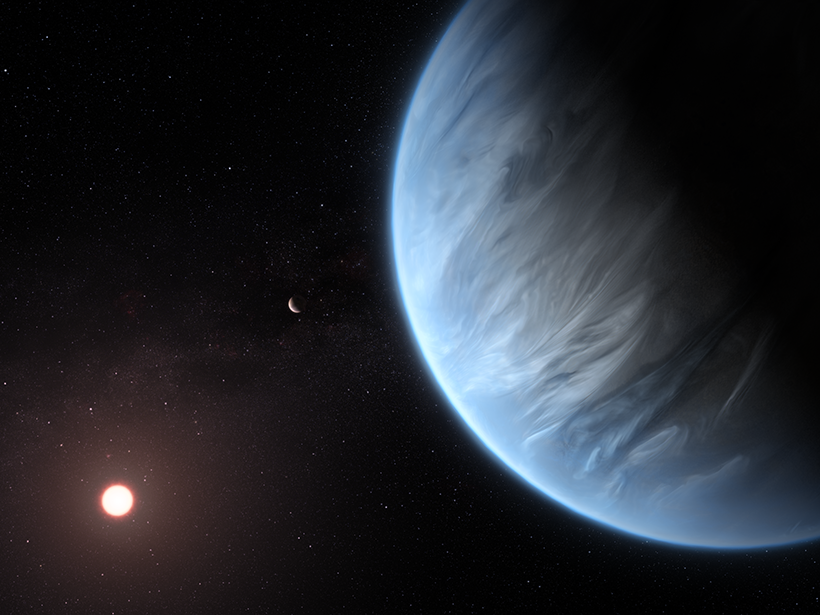Astronomers have detected water vapor in the atmosphere of a planet that orbits within the habitable zone of its star.
“This is the only planet we know of outside the solar system that [has] the correct temperature to support water, has an atmosphere, and has water in it, making this planet the best candidate for habitability we know of right now,” Angelos Tsiaras told reporters. Tsiaras is an astronomer at University College London (UCL) in the United Kingdom and the lead author of a new paper on the planet.
This is also the first time that water vapor has been detected in the atmosphere of an exoplanet that is not a gas giant. The discovery was published in Nature Astronomy on 11 September.
Habitable, but Maybe Not Hospitable
K2-18b was discovered by way of the Kepler Space Telescope in 2015. A few months later, Björn Benneke, an astrophysicist at the Université de Montréal in Canada who was not involved with this study, used the Hubble Space Telescope to observe the planet passing multiple times in front of its star at infrared wavelengths. This technique measures the chemical fingerprint of a planet’s atmosphere as starlight passes through it. Tsiaras and his team analyzed those data with their own software when Benneke’s data became publicly available.
The team found that water vapor left a strong signature in the planet’s atmospheric spectrum. Of the hypothetical atmospheres that the team tested, “they all fit the data, but they all point to a significant concentration of water,” as well as of hydrogen and helium, explained coauthor Jonathan Tennyson, also at UCL.
“It’s not at all clear whether the planet is actually a hospitable environment for life to evolve [in].”
Benneke’s team confirmed the detection of water vapor in a paper under review by the Astronomical Journal and also show that water vapor might condense and rain down through K2-18b’s atmosphere.
“It’s super exciting to have a first glimpse into the atmosphere of a planet this small,” exoplanet researcher Laura Kreidberg told Eos. Kreidberg, of the Harvard–Smithsonian Center for Astrophysics in Cambridge, Mass., said that K2-18b might be “more like a mini-Neptune than a super-Earth because it still has some hydrogen in its atmosphere.”
“This planet is not a second Earth,” Tsiaras added, because it’s twice the size and 8 times the mass of Earth. It also orbits a cool red star less than half the size of the Sun.
“Even though it’s in the habitable zone,” Kreidberg said, “it’s very different from the Earth, and it’s not at all clear whether the planet is actually a hospitable environment for life to evolve [in].” Kreidberg was not involved with this study.
“The Limit of What We Can Do”
“Fundamentally, Hubble wasn’t designed to do observations of exoplanet atmospheres.”
The atmospheric models suggest that water vapor could make up anywhere from 0.01% to 50% of the atmosphere’s composition. The data are not precise enough to narrow down this range or to detect other molecules the atmosphere might have, the researchers found. “With the current data, we can only detect the existence of an atmosphere and the existence of water,” Tsiaras said.
Thomas Beatty, an exoplanet atmosphere researcher at the University of Arizona in Tucson who was not involved with this research, said that for this system, “this appears to be the limit of what we can do with current facilities. Hubble is an amazing observatory, but…fundamentally, Hubble wasn’t designed to do observations of exoplanet atmospheres.”
Upcoming space-based telescopes “were designed from the ground up” to more precise and accurate atmospheric measurements than is currently possible, Beatty said.
And as for telescopes on the ground, Earth’s humid skies complicate the search for water elsewhere. “Ironically,” Tennyson said, “the less like Earth this is, the easier it’s going to be to do from the ground.”
—Kimberly M. S. Cartier (@AstroKimCartier), Staff Writer
Citation:
Cartier, K. M. S. (2019), Water found in small, habitable zone planet’s atmosphere, Eos, 100, https://doi.org/10.1029/2019EO132805. Published on 11 September 2019.
Text © 2019. AGU. CC BY-NC-ND 3.0
Except where otherwise noted, images are subject to copyright. Any reuse without express permission from the copyright owner is prohibited.

